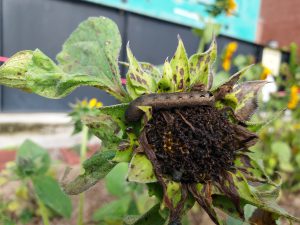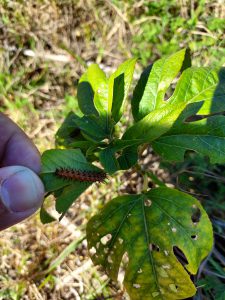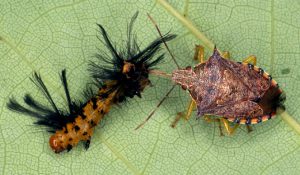Most species of butterflies and moths feed on flower nectar and are harmless to plants. On the other hand, caterpillars can be harmful to crop and ornamental plants.
What are caterpillars and how I can Identify them?
Caterpillars are the larval stage of moths and butterflies. Their color, shape, and size vary among the species. Some species will only affect a particular plant species. Not all caterpillars are considered pests or are of agricultural concern. To know more about different types of caterpillars and what are their plant host click here.

What is their life cycle?
Caterpillars undergo complete metamorphosis, which means they have 4 life stages: egg, larva, pupa, and adult. The shape, color, and size of the eggs vary among the species. The adults are the only ones that have the capacity for reproduction. The time between larva and adult varies among the species but in general, it takes about 30 – 50 days for most species. For most species, the larval stage is longer than the adult stage.
How do they damage my plants?
Caterpillars have a shewing mouthpart. They consume plant materials such as leaves with their mouthparts. Damage caused by caterpillars results in defoliated leaves. The older the caterpillar, the more it consumes. A severe infestation can defoliate a plant in short periods of time.

How can I control caterpillars?
Controlling caterpillars is easier than controlling adult moths or butterflies. The caterpillars are more susceptible to certain methods of control such as chemical control. There are various methods of control for caterpillars:
- Mechanical or physical control:
You can physically remove caterpillars by hand or using tools, although it may be time-consuming. They are slow insects, so is relatively easy just to grab them and eliminate them. Remember that some caterpillars can be venomous so be careful when doing this with your own hands; if you don’t know if the species is venomous, do not touch it with your hands. Also, make sure to look under the leaves because caterpillars tend to hide here.
Although most of the adults are harmless, they still can lay eggs that will turn into larvae, which may harm your plants in the future. Using attractants or sticky traps can help to eliminate some of the adults and help you monitor the population of the pest.
- Biological control:
Caterpillars have natural enemies that can help you control the population. Parasitic wasps, parasitic flies, soldier bugs, ants, and ladybugs (small caterpillars) all feed on caterpillars. You can release some of these natural enemies in your crops or ornamental

plants as a control method.
- Chemical control:
There are several pesticides that are effective in the control of caterpillars. Some examples are horticultural oils, Bacillus thuringensis (Bt), Spinosad, among others. When using pesticides, always follow label instructions to verify if they control caterpillars and to know on what plants they can be sprayed.
Conclusion
Caterpillars can defoliate plants in short periods of time without proper control. Monitoring your plant is important to keep these pests under control so they don’t cause economical losses to your crops or ornamental plants.
If you want to know more about caterpillars access the following “Ask IFAS” publications:
STINGING AND VENOMOUS CATERPILLARS OF THE SOUTHEAST
FALL ARMYWORM, SPODOPTERA FRUGIPERDA (J.E. SMITH) (INSECTA: LEPIDOPTERA: NOCTUIDAE)
AZALEA CATERPILLAR, DATANA MAJOR GROTE & ROBINSON (INSECTA: LEPIDOPTERA: NOTODONTIDAE)
University of Florida is an Equal Opportunity Institution
 0
0
